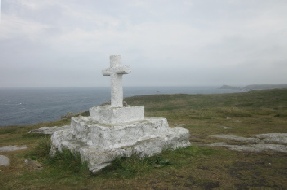
Wendy Mewes writing about Brittany
Sacred geography, an extract from Spirit of Place in Finistere
Brittany’s landscape was brought under the church’s influence through the Breton saints.
Early hagiographies are full of geographical reference. The setting and the landscape are important factors of the story being created. Saints repeatedly exerted their powers – lent by God – over wild paganism, the people and places they found on arrival. The rooting out of brambles and eviction of savage creatures living in that untamed vegetation were part of an essential phase of establishing Christianity. It was a literal and metaphorical sweep of the new broom. Land was cleared for the first settlements around primitive churches, forest areas razed to the ground, seeds planted, new crops harvested, all in the name of the incoming religion. It was said that St Ronan took over a Celtic nemeton or sacred space as his own ritual context in the landscape and that he walked the boundaries of this territory each day.
The close bond between peasants and their land which led to belief in plant and animal spirits, as well as the animism of stones, trees and streams, now had to be sanctioned through the intervention of Christianity. Personal ties were redirected and retied, binding the people to the church and the powers of its ministers, relating the real life of ordinary people to mystical process of religious faith through the medium of human constructs rather than natural wonder and the original sense of awe in the landscape. The miracle of the Resurrection replaced pragmatic aspects of earlier religion when a more reciprocal relationship with gods was envisaged, and sacrifice or offerings might lead in return to good weather and a bumper harvest.
When St Pol was given land by the local lord Withur, he first had to expel the wild inhabitants, including a bear, that lived there. He rid the Ile de Batz of a marauding dragon, that ultimate symbol of rampant paganism, leading it by his bishop’s stole like a dog on a lead, before forcing the great beast from the rocks into the sea at a spot still bearing the name Toul ar Serpent, Serpent’s Hole. The huge Neolithic standing stone Men Marz (later Christianized by the addition of a puny cross) was said to have been placed on the coast by St Pol (or his sister) as a marker beyond which he forbade the sea to encroach, after flooding had badly affected people’s lives. Here the saint puts himself – by virtue of the power of God invested in him -
St Hervé and St Brieuc were both famed for their miraculous taming of wolves, which became docile and submissive under the power of the cross, but an anecdote from the life of the latter also describes the land-
The reasons behind this strategy were many. Christianity offered man defence against the power of nature that had hitherto controlled and dominated people’s lives. Christ was a man offering a way to conquer death, so often faced in difficult terrain. The miracles of the saints aped the powers of older deities, giving the Christian God victory in his rivalry with Nature. The lamb triumphed over the wolf and the dragon. Taking this control of the landscape drove a wedge between man and the animated landscape of the Celtic world. Lore was berated as superstition and the intimacy of the sacred bond with the earth was broken. Spontaneity of inter-

© Wendy Mewes -